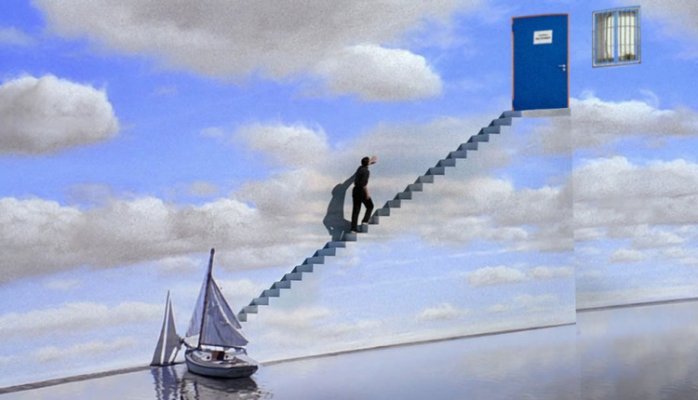KNOWLEDGE AND THE KNOWER—
WHAT COUNTS AS KNOWLEDGE?
THE ALLEGORY OF THE CAVE
Back Mouth Cave. Photo: Sam West WRK900
The Allegory of the Cave is a powerful metaphor for a variety of knowledge problems encountered in TOK. Picturing, in the mind’s eye, the denizens of Plato’s Cave evokes the human condition in its inherent capability and fallibility.
Here are some thoughts for the teacher to keep in mind as they facilitate a student first encounter with the The Allegory of the Cave:
Here we are in the thick of the action.
We are smart apes—embodied, and culturally embedded.
We are here only once—thrown, without being consulted, into a particular place and time to navigate the interim between the contingency of being born, and the absolute certainty of death.
Our senses, languages, mental maps, clever logic, complex emotions, constructed memories, intuitions and vivid imaginings, enable us to perceive and understand our world. But they are fallible as well as capable.
These bullet points have been distilled from the Who wants to know? introductory pages; which touch upon certain inescapable aspects of the human predicament that have undergirded my own approach to teaching TOK.
Mara Lea Brown (2005) Plato's Allegory of the Cave. Ink on paper.
CLASS ACTIVITY I:
ENCOUNTER WITH PLATO'S ORIGINAL TEXT
Students will participate in three cumulative readings of an extract from Chapter VII of Plato's Republic which introduces the The Allegory of the Cave:
1. Students read through the text in silence.
2. One student is appointed to play Socrates, another plays Plato's compliant brother—a man of very few words—Glaucon. Whilst the players perform the dialog, the remainder of the class with closed eyes try to form a mental picture of the denizens of the cave.
3. The students are handed a copy of the cartoon. Socrates and Glaucon repeat their performance. This time the students examine and try to make sense of the cartoon illustration.
Pdf. of student copies of the full text and cartoon.
TEXT EXTRACT
"Behold! human beings living in a underground den, which has a mouth open towards the light and reaching all along the den; here they have been from their childhood, and have their legs and necks chained so that they cannot move, and can only see before them, being prevented by the chains from turning round their heads. Above and behind them a fire is blazing at a distance, and between the fire and the prisoners there is a raised way; and you will see, if you look, a low wall built along the way, like the screen which marionette players have in front of them, over which they show the puppets…
And do you see, I said, men passing along the wall carrying all sorts of vessels, and statues and figures of animals made of wood and stone and various materials, which appear over the wall? Some of them are talking, others silent... Like ourselves… they see only their own shadows, or the shadows of one another, which the fire throws on the opposite wall of the cave?"
INTERIM GUIDING QUESTIONS
It has been said that European philosophy is a series of footnotes to Plato. At the very least we can say The Allegory of the Cave has been a very persistent meme for 2400 years. Kick start whole class reflection and discussion with the following generative questions:
What is going on here?
To what extent if any does your own experience as a knower and a learner resonate with Plato’s cave metaphor?
Francisco Goya (1799) Detail from Los Caprichos No. 39: Asta su Abuelo (And so was his grandfather). Aquatint. Museo del Prado, Madrid. .
CLASS ACTIVITY II:
TRUMAN SHOW—ON THE AIR, UNAWARE
Without spoilers view The Truman Show (1998) trailer. Immediately solicit student responses. Follow up by working through the six guiding questions. Share the claymation adaptation of The Allegory of the Cave at the halfway point.
The cathartic closing scene from The Truman Show (1998)
GUIDING QUESTIONS
1. Truman is “on the air, unaware.” Is ignorance bliss?
2. What parallels do you notice between Truman’s imprisonment in the Seahaven dome and the denizens of Plato’s cave?
3. To what extent are we all being duped by product placements and false realities presented to us by commercial advertising and social media?
4. What, if any, are the essential differences between Truman’s predicament and our own?
5. “A robin redbreast in a cage, Puts all heaven in a rage.” What has William Blake’s couplet from Auguries of Innocence (1863) got to do with the Truman show?
6. What specific ethical objections arise from the “forbidden experiment” imposed on Truman since his birth in front of a live audience?
7. How is Truman eventually able to recognize his predicament? What does this say about human fallibility and capability?
8. What emotional states are involved in the final scene?



